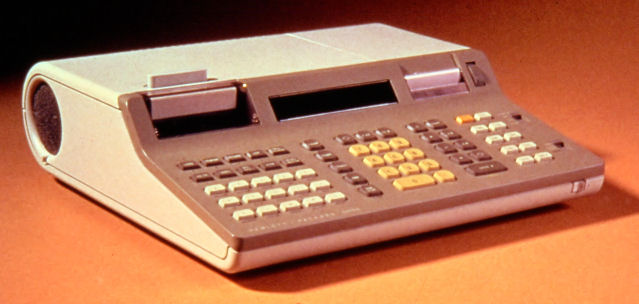|
The HP 9815A
As the first of the third-generation desktop calculators to be introduced, HP’s 9815A calculator represented an odd mix of firsts and lasts. It was the first calculator from HP to use an off-the-shelf, commercial microprocessor: the Motorola MC6800. It was HP’s first desktop calculator to use the new, “high-speed” DC100 data cartridge that HP developed in collaboration with 3M. It was also the first desktop calculator to use HP Loveland’s NMOS II chips, in the form of seven language and option ROMs. As such, it was an excellent test platform for many of the new technologies that also appeared in the HP 9825A. The HP 9815A was the first (and also the last) desktop calculator to use a single-line, 7-segment plasma display with very limited alphabetic abilities.
Even with all of these firsts, the HP 9815A was the last of its kind. It was a programmable RPN (reverse-Polish notation) desktop calculator like Tom Osborne’s first-generation HP 9100 calculator, which had been succeeded by the second-generation HP 9810A desktop calculator. The HP 9815A was much smaller, lighter, and cheaper than the first- and second-generation machines. Perhaps the HP 9815A team succeeded too well because the HP 9815A it would be the last programmable RPN desktop calculator created by HP’s Calculator Products Division (CPD).
During the 6-year period that HP would sell the HP 9815A and its successor—the HP 9815S, which appeared in 1978—the Calculator Products Division (CPD) would change its name to the Desktop Computer Division (DCD). This name change signaled a change in focus for the division. It no longer wanted to sell lower-cost products like the $2900 HP 9815A. When the $3990 HP 9815S was discontinued around 1983, DCD’s top-of-the-line HP 9845C Model 290 desktop computer was selling for $54,000. DCD decided to let HP’s handheld-calculator division keep the low-end for itself and indeed, the CRT-based HP 85 would appear in late 1979, selling for $3250.
Code name CJ
The code name for the HP 9815A project was “CJ,” which stood for Caesar Julius. Originally planned as “Julius Caesar,” the abbreviation “JC” didn’t fly with the more religious R&D staffers so the letters in the abbreviation were simply reversed. The HP 9815A project manager was Doug Clifford, who joined HP after getting his BSEE from Brigham Young University in 1968. Clifford had originally worked on spectrum analyzers at HP. After three years of working on instrumentation, and getting an MSEE from Stanford in the process, Clifford joined CPD and worked on the HP 46 and HP 81 calculators with Don Morris, who would become the project manager on the HP 9825A project.
In fact, there was a healthy competition between Clifford and Morris during the simultaneous development of the HP 9815A and 9825A desktop calculators. However, the competition was surely one-sided. Morris’s development team had a bigger power supply and a better processor to work with. The HP 9825A would also sell for about twice the sales price of the HP 9815A so the HP 9825A designers had far more manufacturing cost to work with. Consequently, the HP 9825’s cartridge tape drive and printer both outperform those in the HP 9815A, even though both machines use the same basic tape-drive and printer mechanicals.
Even with its power, size, and cost disadvantages, the HP 9815A made a substantial addition to CPD’s product line. It had two optional I/O slots (standard in the HP 9815S) that accommodated a full complement of I/O cards including a parallel I/O card, a BCD card, an HPIB card, and a serial I/O card, so it was a full-fledged HP instrument controller in every sense of the word.
|

|
|
HP 9815A
Photo courtesy of Fred Wenninger
|
|
References
Information on this page came from:
Douglas M. Clifford, F Timothy Hickenlooper, and A. Craig Mortensen, “Mid-Range Calculator Delivers More Power at Lower Cost,” HP Journal, June, 1976, p 24-32.
|